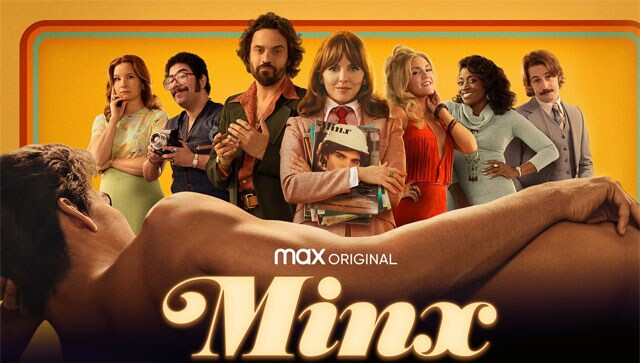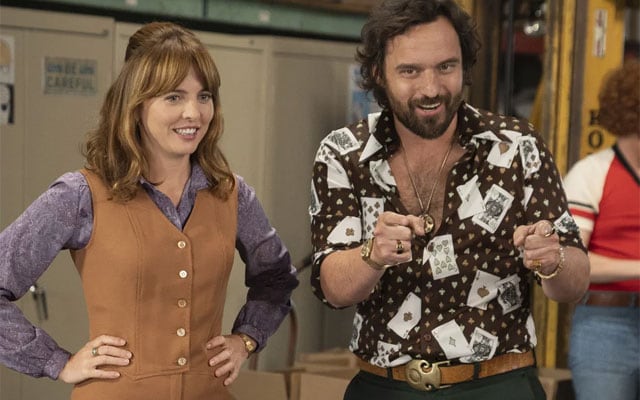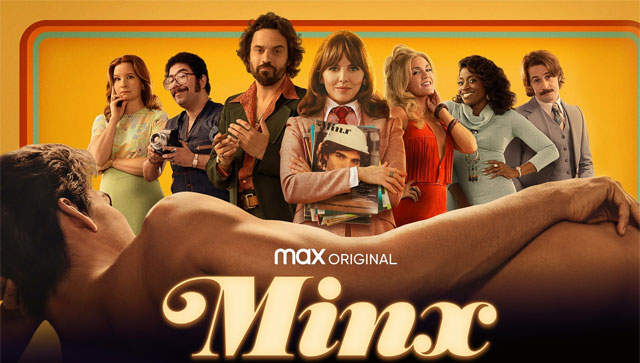An unfortunate trick played by studios and marketing departments in the streaming era is to convince creators that TV shows can be either 100% frivolous or an equally extreme grade of Big and Serious. It’s quite rare to come across sitcoms today that have a distinctive, non-trivial voice (and therefore, politics) of their own without sacrificing the kineticism and frisson of their dialogue. One of the best comedy shows of the year threads this needle perfectly — Ellen Rapoport’s Minx, starring Ophelia Lovibond and Jake Johnson. The show was released in America earlier this year on HBO Max, and it’s finally streaming in India, on Lionsgate Play (as well as the ‘add-on’ Lionsgate channel on Amazon Prime Video). The narrative follows Joyce Prigger (Lovibond), a young feminist in Los Angeles who forms an unlikely partnership with Doug Renetti (Johnson), a low-budget publisher of pornographic magazines with names like ‘Giant Jugs’ and ‘Bad Girls High’. Joyce wants to create a high-concept, academic-adjacent feminist magazine called ‘The Matriarchy Awakens’ but after talking to Doug—and observing what women around her actually read—she gets on board with the titular ‘Minx’, the first-ever erotica magazine targeting a female readership, complete with a nude male centrefold in every issue. As Doug tells Joyce during their first, hilarious encounter, you have to hide the medicine from the dog in layers of peanut butter. “What’s your peanut butter,” he asks Joyce with the affectionate look of a crusty old dog encountering a familiar brand of naivete. To that end, there’s a lovely sequence towards the end of the first episode, where Joyce finally comes around to the idea of an erotic magazine for women. The camel’s back is broken by Cosmopolitan featuring TV star Burt Reynolds as their first-ever male centrefold (well, kind of, since the nudity is only… implied, not explicit). Joyce sees her sister—and various other women—on her way to work, enjoying a private chuckle as they’re reading Cosmopolitan. Even more tellingly, when Joyce finally reaches her office building (which houses several magazine offices), she sees a creepy, middle-aged ex-colleague named Cory we had seen earlier in the episode. He had been massaging a young female employee’s shoulders without consent, telling her lasciviously, “Y’know, you should do this for your boyfriend, get him nice and hot”. Now, we see that same young woman taunting Cory by saying, “You should do this for your girlfriend, Cory, get her good and hot”. Cory retreats, stammering, “That’s inappropriate for the workplace” In a powerful bit of dialogue, Joyce tells Doug that she is convinced, that she has realized the power of subverting the male gaze, of giving women the power to look for a change. “I thought you were just a tacky salesman with a cheap gimmick, and you kind of are, but you do know something that I’m just figuring out. That a magazine has…it’s got to make you feel something, and seeing a naked guy does that to women. Whether they’re curious, or turned on, or just want to laugh at him, the ability to look makes a woman feel powerful. That’s what our magazine is all about.” Lovibond and Johnson are both excellent, as is the rest of the cast. Minx is really, really funny and it captures the giddiness of the sexual revolution of the 1960s and 70s adroitly. Even more importantly, it knows how to highlight the limitations of Joyce’s revolution —namely, it’s mostly for white women—and occasionally, poke fun at itself. At the beginning of the second episode, Joyce is overjoyed with the results of Minx’s first-ever centrefold photoshoot—a nude male model with a hard hat and a utility belt, the kind favoured by construction workers. Earlier in the show, we had seen Joyce being catcalled by a group of construction workers and she’s now repaying the favour by designing this photoshoot. Joyce says, oblivious to how bookish she’s sounding to the rest of the team, “I love that we’re saying something, you know! You see the pain in his eyes? It’s like he’s internalizing the harassment endured by generations of women!” Her colleague retorts, “That’s actually the moment he found out what we’re paying him.” [caption id=“attachment_11621421” align=“alignnone” width=“640”] Minx[/caption] The first second sexual revolution While the sexual revolution of the 1960s and 70s did turn the tide on a number of societal conventions and policy matters (access to reproductive health resources being a big one), it isn’t really considered as the first wave. That honour belongs to the 1920s, a time when the First World War (as well as America’s Prohibition laws) had loosened orthodoxy’s grip on society. In America, jazz was in the air, ‘flapper girl’ subculture and the women’s suffrage movements were some of the prominent talking points of the day. It was inevitable that sexual mores would change at a hitherto unseen pace. However, the 1960s and 70s brought forth a number of widespread attitude shifts, some of which were instrumental in shaping contemporary views on sex, marriage and morality. The formalization of the pornographic industry was one of these changes—it was still frowned upon (Joyce’s ex-boyfriend basically pleads her to stop making Minx for the same reason) but it was legal. The beginnings of the sexual revolution has inspired several films and TV shows down the years. In the first episode of Minx, Joyce asks the magazine staff to read some books she’s procured for them—including the Kinsey Reports, scholarly works on human sexual behavior published in the 1940s and 50s. Similarly, from 1957 to the early 1990s, William Masters and Virginia Johnson conducted pioneering research into sexual responses as well as dysfunctions; from 2013-16 their story was fictionalized for the superb Showtime series Masters of Sex, starring Michael Sheen as Masters and Lizzy Caplan as Johnson. At its best, Masters of Sex was one of the smartest, funniest shows on television, during an era overstuffed with ‘prestige dramas’. [caption id=“attachment_11621431” align=“alignnone” width=“640”]
Minx[/caption] The first second sexual revolution While the sexual revolution of the 1960s and 70s did turn the tide on a number of societal conventions and policy matters (access to reproductive health resources being a big one), it isn’t really considered as the first wave. That honour belongs to the 1920s, a time when the First World War (as well as America’s Prohibition laws) had loosened orthodoxy’s grip on society. In America, jazz was in the air, ‘flapper girl’ subculture and the women’s suffrage movements were some of the prominent talking points of the day. It was inevitable that sexual mores would change at a hitherto unseen pace. However, the 1960s and 70s brought forth a number of widespread attitude shifts, some of which were instrumental in shaping contemporary views on sex, marriage and morality. The formalization of the pornographic industry was one of these changes—it was still frowned upon (Joyce’s ex-boyfriend basically pleads her to stop making Minx for the same reason) but it was legal. The beginnings of the sexual revolution has inspired several films and TV shows down the years. In the first episode of Minx, Joyce asks the magazine staff to read some books she’s procured for them—including the Kinsey Reports, scholarly works on human sexual behavior published in the 1940s and 50s. Similarly, from 1957 to the early 1990s, William Masters and Virginia Johnson conducted pioneering research into sexual responses as well as dysfunctions; from 2013-16 their story was fictionalized for the superb Showtime series Masters of Sex, starring Michael Sheen as Masters and Lizzy Caplan as Johnson. At its best, Masters of Sex was one of the smartest, funniest shows on television, during an era overstuffed with ‘prestige dramas’. [caption id=“attachment_11621431” align=“alignnone” width=“640”] Minx[/caption] In 2017, David Simon (the creator of The Wire, one of the most acclaimed TV shows of all time) and George Pelecanos created The Deuce, a TV show starring James Franco and Maggie Gyllenhaal. The story was set in ‘The Golden Age of Porn’ (1969-1984 or so), which covered the legalization and formalisation of the porn industry in and around New York in the 1970s. Gyllenhaal’s performance, as a sex worker who becomes a film director (cutting her teeth on porn, of course), was outstanding and The Deuce worked as a character-driven drama that also had original and interesting things to say about the history of the sexual revolution. A slightly older film that must be mentioned amidst these excellent contemporary TV shows is Miloš Forman’s The People vs Larry Flynt (1996), a biographical film about the life and works of Larry Flynt (played by Woody Harrelson), the founder of Hustler, one of the oldest pornographic magazines in America. Woody Harrelson excelled as Flynt, who became the unlikely face of free speech in America after winning a landmark case in front of the US Supreme Court in 1988—Hustler Magazine vs Falwell, involving a parody Hustler had published targeting conservative televangelist Jerry Falwell. What does Minx add to this excellent line-up? For one, it adds a touch of intersectionality. In an excellent scene from the very first episode, Joyce sees a Black woman, Tina (Idara Victor), pouring coffee for Doug Renetti in the latter’s office and immediately assumes this must be Doug’s secretary. “Why, do I remind you of the staff at your tennis club?” Tina asks Joyce pointedly. Joyce stammers, fumbling for an answer before both Doug and Tina burst out laughing; turns out Tina is indeed Doug’s longstanding secretary—and as, we learn later, key ally and confidante who has a real aptitude for business. Not only is this scene an excellent way to introduce a new character, it’s a way to ensure that Joyce is not lionised outright as a trailblazer. We are reminded that some of the first feminist movements captured the public’s attention precisely because these were white-dominated newspapers and TV channels reporting on the grievances expressed by white women. It’s significant that Gloria Steinem is mentioned more than once as Joyce’s idol (she even turns up in Joyce’s dreams as a moral authority of sorts) — and not, say, Angela Davis. It’s this thoughtfulness combined with obvious comedic chops that makes Minx a special show. A second season has already been confirmed by HBO and this time around, I hope Indian fans get to see it at the same time as the rest of the world.
Minx[/caption] In 2017, David Simon (the creator of The Wire, one of the most acclaimed TV shows of all time) and George Pelecanos created The Deuce, a TV show starring James Franco and Maggie Gyllenhaal. The story was set in ‘The Golden Age of Porn’ (1969-1984 or so), which covered the legalization and formalisation of the porn industry in and around New York in the 1970s. Gyllenhaal’s performance, as a sex worker who becomes a film director (cutting her teeth on porn, of course), was outstanding and The Deuce worked as a character-driven drama that also had original and interesting things to say about the history of the sexual revolution. A slightly older film that must be mentioned amidst these excellent contemporary TV shows is Miloš Forman’s The People vs Larry Flynt (1996), a biographical film about the life and works of Larry Flynt (played by Woody Harrelson), the founder of Hustler, one of the oldest pornographic magazines in America. Woody Harrelson excelled as Flynt, who became the unlikely face of free speech in America after winning a landmark case in front of the US Supreme Court in 1988—Hustler Magazine vs Falwell, involving a parody Hustler had published targeting conservative televangelist Jerry Falwell. What does Minx add to this excellent line-up? For one, it adds a touch of intersectionality. In an excellent scene from the very first episode, Joyce sees a Black woman, Tina (Idara Victor), pouring coffee for Doug Renetti in the latter’s office and immediately assumes this must be Doug’s secretary. “Why, do I remind you of the staff at your tennis club?” Tina asks Joyce pointedly. Joyce stammers, fumbling for an answer before both Doug and Tina burst out laughing; turns out Tina is indeed Doug’s longstanding secretary—and as, we learn later, key ally and confidante who has a real aptitude for business. Not only is this scene an excellent way to introduce a new character, it’s a way to ensure that Joyce is not lionised outright as a trailblazer. We are reminded that some of the first feminist movements captured the public’s attention precisely because these were white-dominated newspapers and TV channels reporting on the grievances expressed by white women. It’s significant that Gloria Steinem is mentioned more than once as Joyce’s idol (she even turns up in Joyce’s dreams as a moral authority of sorts) — and not, say, Angela Davis. It’s this thoughtfulness combined with obvious comedic chops that makes Minx a special show. A second season has already been confirmed by HBO and this time around, I hope Indian fans get to see it at the same time as the rest of the world.
Aditya Mani Jha is a Delhi-based independent writer and journalist, currently working on a book of essays on Indian comics and graphic novels. Read all the Latest News , Trending News , Cricket News , Bollywood News , India News and Entertainment News here. Follow us on Facebook , Twitter and Instagram .
)